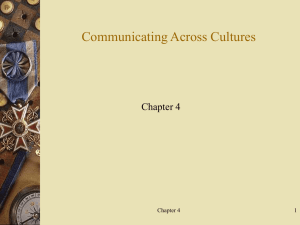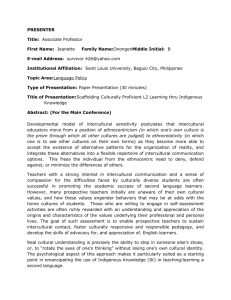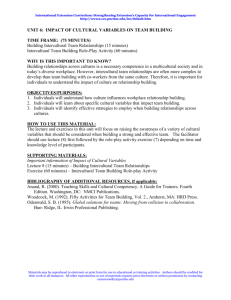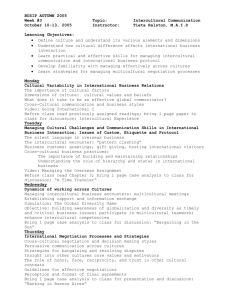Highlighting the Merits and Demerits of High and Low Context
advertisement
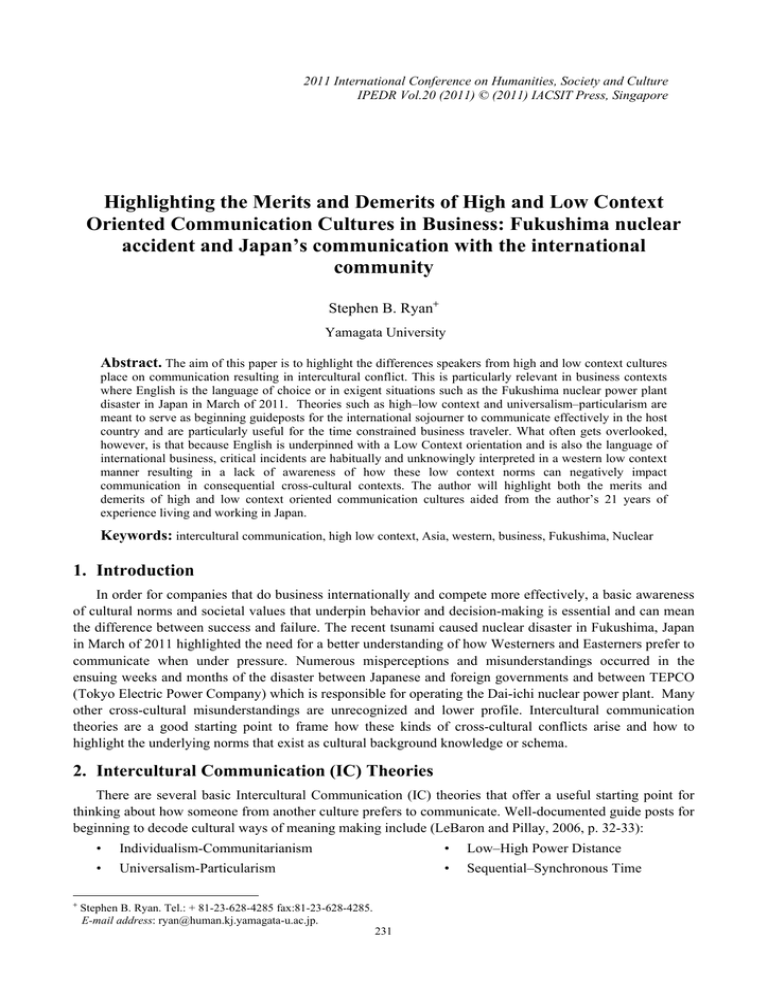
2011 International Conference on Humanities, Society and Culture IPEDR Vol.20 (2011) © (2011) IACSIT Press, Singapore Highlighting the Merits and Demerits of High and Low Context Oriented Communication Cultures in Business: Fukushima nuclear accident and Japan’s communication with the international community Stephen B. Ryan+ Yamagata University Abstract. The aim of this paper is to highlight the differences speakers from high and low context cultures place on communication resulting in intercultural conflict. This is particularly relevant in business contexts where English is the language of choice or in exigent situations such as the Fukushima nuclear power plant disaster in Japan in March of 2011. Theories such as high–low context and universalism–particularism are meant to serve as beginning guideposts for the international sojourner to communicate effectively in the host country and are particularly useful for the time constrained business traveler. What often gets overlooked, however, is that because English is underpinned with a Low Context orientation and is also the language of international business, critical incidents are habitually and unknowingly interpreted in a western low context manner resulting in a lack of awareness of how these low context norms can negatively impact communication in consequential cross-cultural contexts. The author will highlight both the merits and demerits of high and low context oriented communication cultures aided from the author’s 21 years of experience living and working in Japan. Keywords: intercultural communication, high low context, Asia, western, business, Fukushima, Nuclear 1. Introduction In order for companies that do business internationally and compete more effectively, a basic awareness of cultural norms and societal values that underpin behavior and decision-making is essential and can mean the difference between success and failure. The recent tsunami caused nuclear disaster in Fukushima, Japan in March of 2011 highlighted the need for a better understanding of how Westerners and Easterners prefer to communicate when under pressure. Numerous misperceptions and misunderstandings occurred in the ensuing weeks and months of the disaster between Japanese and foreign governments and between TEPCO (Tokyo Electric Power Company) which is responsible for operating the Dai-ichi nuclear power plant. Many other cross-cultural misunderstandings are unrecognized and lower profile. Intercultural communication theories are a good starting point to frame how these kinds of cross-cultural conflicts arise and how to highlight the underlying norms that exist as cultural background knowledge or schema. 2. Intercultural Communication (IC) Theories There are several basic Intercultural Communication (IC) theories that offer a useful starting point for thinking about how someone from another culture prefers to communicate. Well-documented guide posts for beginning to decode cultural ways of meaning making include (LeBaron and Pillay, 2006, p. 32-33): + • Individualism-Communitarianism • Low–High Power Distance • Universalism-Particularism • Sequential–Synchronous Time Stephen B. Ryan. Tel.: + 81-23-628-4285 fax:81-23-628-4285. E-mail address: ryan@human.kj.yamagata-u.ac.jp. 231 • Specificity-Diffuseness • High-Low Context With regards to many Asian countries, perhaps the most influential theory is Hall’s high and low context (1976) communication theory. 2.1. High Low Context Communication Orientation Hall’s (1976) theory of high and low context culture explains the basic types of communication speakers from collectivistic and individualistic cultures norms typically prefer. According to this theory, a high context (HC) culture, such as Japan, is characterized by nonverbal communication and meanings shared implicitly by speaker/listener that are highly dependent on the context. A high context culture orientation is one in which information is shared consistently by all members of the same group. This communication preference allows information to continually build up and be modified; thereby maintaining a high level of context so that literal utterances are not needed. The emphasis of the utterance is placed on how and by whom because there is meaning already associated with the context in which it is spoken. Conversely, low context (LC) oriented cultures (e.g. US) are said to value explicit literal communication between speaker/listener; The proverb, “the squeaky wheel always gets the grease” shows the Western value of explicitly speaking what’s on your mind or risk losing some advantage. Low context cultures tend to place less emphasis on context and more value on the individual’s content of the message in order to “better predict listener’s behavior in direct communication” (Gudykunst, et. al 1993:151). High context cultures typically value good relationships to their in-group members more than low context cultures. 2.2. High-Low Context Criticism From a strictly academic context of considering human knowledge and behavior, the HC-LC theory is indeed limited and has been strongly criticized recently (Guest 2009, Holliday et. al 2010) for causing the opposite of what it intends to do - causing damaging stereotypes resulting in more miscommunications and misunderstandings. IC theories are indeed essentialist theories in that they attempt to define a set of characteristics that communities of people tend to follow to make meaning in specific situations. A nonessentialist view, on the other hand, maintains that, “culture is a shifting reality anyway, people make of it what they need to live their identities in different circumstances” (Holliday, et. al, 2010:15). Furthermore, an essentialist view uses prescribed information (i.e. high/low context) and attempts to “define the person before understanding the person” (Holliday, et. al, 2010:11). However, this line of thinking, while noble, also serves to obfuscate IC in two areas. First, it is practically impossible, and potentially naively individualistic, to suggest that, “we should take every fact of what they do and say seriously” when communicating with someone from a different background (Holliday, et. al, 2010:16). How we communicate is largely underpinned by a deep culture of unrecognized background knowledge. Thus, it will be extremely difficult, nigh impossible, to modify big C cultural norms if we are not aware of them and how they are affecting our communication. We draw from a pool of this assumed knowledge, or cultural schema, to fill-in the blanks in ambiguous situations. For example, in a contentious face-losing context, the Japanese speaker would draw off of high context oriented cultural schema to attempt to consider what impact a decision would have on others in their group and what affect it may have on in-group relationships before giving any firm or direct answer. Equivocating phrases such as, “I wonder what other’s think” or “We need to examine the matter more closely”, are HC speak for, ‘we need to build a consensus before making a decision.’ It is one thing to state that all human beings should be universally understood on a one-to-one basis but quite another in attempting to do so in any practical sense where consequential decisions are involved, lives at stake that require timely cross-cultural negotiation or with billions of dollars of government or private contracts hanging in the balance. The western business sojourner is typically trying to achieve as much as possible in the least amount of time (a deep cultural LC norm) and highly values pragmatic, timely results over time consuming, consensus-making, face saving negotiations (deep HC norms) that consider the needs of each individuals within groups. Finally, the definition of culture itself is important as it is concerned with group norms, values and how they are valued in different degrees within the communities. IC theories have lasted this long for a good reason. They are useful starting points, guideposts to help make intercultural interaction more understandable and approachable. Intercultural theories such as high-low context are perhaps best considered a continuum that individuals fit on at different points in their lifetimes with some exhibiting more 232 or less big cultural attributes than others depending on how well defined the context is. Divergent behavior occurs when the other speaker does not follow the commonly accepted group norms of communicating. In addition, communication can largely be context driven especially if the larger cultural norms are perceived as being met or fulfilled. 3. English as a LC Global Tool for Business Communication The English language has become an indispensable tool for international business communication. English has become the medium enabling billions of people worldwide to communicate in a language outside their mother tongue and national culture. Possibly, it has succeeded in becoming the international language of choice not only because of the economic prowess of the English speaking countries but also because the underpinning cultural values of the language are particularly conducive for effective communication in intercultural contexts which have a high degree of ambiguity among speakers. In business, clarity is vital to a successful interaction and there is often little time to build context. As a language, it is ideally suited to fill this role due to its LC orientation. A low context way of communicating values explicitness and directness as way of showing one’s honesty and trustworthiness. “Americans, in particular, need and thrive on specificity because theirs is largely a low-context culture” (Donahue, 1998:170). Having things spelled out or communicated presumes - via cultural schema - that we can avoid miscommunication with people from varied backgrounds. High context (HC) cultures, such as Korea and Japan, strongly value interpersonal harmony, social hierarchy and consensus decision-making. This reinforces a more cooperative, indirect way of communicating. There is a higher degree of tolerance for language ambiguity in high context cultures than in low ones because the context is expected to fill in the blanks as opposed to language itself. In sum, cultural orientation and schema oblige the manner in how language is used and interpreted and holds the key to meaning making because we are forced to “be attentive to certain details in the world and to certain aspects of experience that speakers of other languages many not be required to think about all the time” (Deutscher, “Does Language Shape How You Think?”, 2010). 3.1. The TEPCO Fukushima Nuclear Misunderstanding High-Low cultural orientation often leads to significant misunderstandings in critical cross-cultural contexts. For example, soon after the Tohoku earthquake and tsunami in March of 2011, Americans and Japanese differed in their approach to data interpretation and decision-making according to their HC and LC norms. The New York Times (Tabuchi and Bradsher, 2011) reported that the Japanese government was more interested in presenting, “a blizzard of facts and numbers but rarely make broader declarations about the conditions” of the nuclear crisis. The Japanese media, on the other hand, criticized the American and foreign media of exaggerating the situation and failing to take into account all the facts. Considering theoretical framework discussed above, we can see that the US is strongly relying on (and expects) a LC approach. In other words, nuclear data deemed most important was extrapolated by computer models and used to interpret and make decisions quickly. We can see from these two approaches to decision-making that each is following the norms of their HC or LC cultural orientation. The Japanese are attempting to build a more time consuming high context approach to collecting and disseminating information so that everyone can agree on what course of action to take if any. The US, side preferred a low context approach that focuses on key data, ignoring information considered irrelevant (e.g. the social role, type of agency) and made decisions based on this. This high-low context approach to communicative decision-making is well collaborated by the cognitive cross-cultural research (Nisbett, 2003:90). For instance, Nisbett found that when Japanese and Americans look at a picture of a fish aquarium, the Americans tended to focus on the biggest fish that stands out while ignoring the surrounding context. Japanese, on the other hand, first select the background objects as they related to the environment as a whole. 4. Merits and Demerits of HC-LC in Intercultural Business Contexts In the international business context where English is the medium for communication, a high context approach is problematic unless both low and high context oriented participants are aware of their own norms of communication that unconsciously affect how they communicate and react. While HC oriented communication cultures often see LC speakers as immature, impatient or insensitive to others, the LC 233 oriented speakers sometimes are left with a feeling of insincerity and untrustworthiness (Akasu and Asao 1993:99) when dealing with HC oriented speakers. “It's a perennial complaint in the overseas operations of Japanese companies that they don't get enough information from Japan, to the point where they begin to wonder if things are being deliberately hidden from them” (Rudlin 2011:32). These kinds of misperceptions are based on unrecognized cultural schema and were also played out fully in the aftermath of the Fukushima nuclear disaster. Moreover, building a consensus - a highly desirable act in HC cultures like Japan - is seen in a mostly negative light by Western LC business people. “Relying on consensus means that decisions are made slowly, if at all. With so many people to please, the result is often a mediocre morass of compromises. And with so many hands involved, there is no accountability; no reason for individuals to excel; no sanction against bad decisions so that there are fewer of them in the future” (The Economist, 2008: 14). To overcome these types of negative interpretations, it is useful to consider the assumptions and weaknesses that both HC and LC cultures make. In the tables below, the merits and demerits of both HC and LC oriented communicators are listed in regards to intercultural business interaction. Table 1 Demerits of HC-LC LC HC poor relational harmony can make interaction less efficient, cause strained workplace relations, poor teamwork Often not as efficient or productive Individuals not pushed to maximum efficiency over emphasis of final outcome may be harmful in long term, harm commitments to future interaction or personal development deemphasizing the individual can stifle personal development; dampen motivation greater possibility of wasted talent and time if lack of interest in task saving face mentality in workplace can prevent progress, negatively influence outcomes personal responsibility creates more stress on individuals, can lead to decisions that are not best for group as a whole difficulty in making/maintaining deeper relationships; high job mobility harms loyalty past orientation can slow change for positive future growth; stagnation lack of consideration of the past/present can cause failure in the future lack of competition harms innovation, creativity lack of transparency in dealing with those outside the group case-by-case standard to allow for flexibility can more easily result in discrimination higher relational competition can result in selfishness and/or lack of cooperative spirit overly narrow job description mean less flexibility in the workplace; responsibilities are not shared; task only as good as individual implementation of planning can break down more easily due to lack of consensus project planning takes more time to build 234 Table 2 Merits of HC-LC LC HC Greater efficiency and productivity in short term Stronger human relationships, bonds Allows future interactions to be smoother, increasing productivity Initial planning is faster Risk-taking is encourage by focusing on outcome Holistic approach The process is as important as the outcome Much easier to “cut and run” when things go wrong; easier to start over Better cooperative spirit Future orientation encourages a pragmatic approach Focus on “being” and “progress” (non only outcome) is less stressful, makes goals seem more attainable Task outcome orientation allows individual to maximize focus, become more competent faster Implementation is often faster, efficient 5. Discussion A vast amount of the world’s business is done in English which assumes a LC orientation to communication. Yet, speakers from other cultural orientations do not discard a lifetime of norms and values to communicate but rather continue to rely on and use their native cultural norms to interpret and make meaning. Both HC and LC oriented communicators need to become consciously aware of the disadvantages and advantages of their own communication tendencies and not just the other’s communication preference to have a better chance of a success in intercultural business interaction. 6. References [1] K. Akasu and K. Asao. Sociolinguistic Factors Influencing Communication in Japan and The United States. In Gudykunst, W.B. (Ed). Communication in Japan and the United States, State University of New York Press, Albany, N.Y. 1993: 89-118. [2] G. Deutscher. Does Your Language Shape How You Think? Retrieved from The New York Times online at http://www.nytimes.com/2010/08/29/magazine/29language-t.html. August 29, 2010. [3] R.T. Donahue. Japanese Culture and Communication. Critical Cultural Analysis. Lanham MD: University Press of America, 1998. [4] W.B. Gudykunst, and T. Nishida. Interpersonal and Intergroup Communication in Japan and The United States. In Gudykunst, W.B. (Ed) . Communication in Japan and the United States, State University of New York Press, Albany, N.Y. 1993: pp. 149-188. [5] E. T. Hall. Beyond Culture. Garden City, NY: Doubleday, 1976. [6] A. Holliday, M. Hyde and J. Kullman. Intercultural Communication. An advanced resource book for students. New York: Routledge, 2010. [7] M. LeBaron and V. Pillay. Conflict Across Cultures. A Unique Experience of Bridging Differences. Boston, MA: Intercultural Press, 2006. [8] R. E. Nisbett. The Geography of Thought. How Asians and Westerners Think Differently…and Why. New York: Free Press, 2003. [9] Business in Japan. Taking a Leaf Out of His Book. The Economist. 2008, August 7: 14. [10] M. Guest. Is English Really Low-Context? The Daily Yomiuri. Tokyo, Japan, June 23, 2009: 14. [11] P. Rudlin. Communication depends on the process as well as the people. The Nikkei Weekly. July 18, 2011. [12] H. Tabuchi and K. Bradsher. Lack of Data Heightens Japan’s Nuclear Crisis. The New York Times. April 9, 2011: A4. 235


